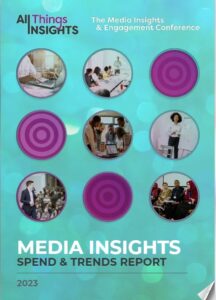1. The Age of Artificial Intelligence (AI)
Perhaps no trend is making more waves in the insights field than the rapid advancement of generative AI. While some industry leaders observe that AI has been around for several years already, and collectively we just didn’t necessarily realize it, TMRE felt like a coming-of-age party for the rapidly developing insights tech tool. In fact, TMRE held an AI Summit all day Sunday, before the official opening of the show, to explore the hot topic.
“It’s the dawn of the AI revolution in market research,” proclaimed David Boyle, TMRE chairman, as he opened the AI Summit.
There are many new aspects of AI that we are all striving to understand, as the technology is still in the early testing stages for the field. There will be many challenges as well opportunities for the insights industry in terms of data quality and storytelling with data, among other issues. Boyle pointed to deeper insights that are perhaps faster and cheaper than the insights research of the past. The advancement of AI holds significance for insights, which is always fighting for relevance at the strategy table, noted Boyle. Further, the power of AI holds profound possibilities for the insights and data science fields, he concluded.
While much remains unclear about the future of AI, such as the possibility of more regulations to come and the governance of it, as well as the questions surrounding legal, security and privacy implications, the insights industry overall feels open, positive and ready to embrace new tools and technology. As several presentations during the show highlighted, most feel that the human element will still be an important factor in the oversight of AI within insights. The combination of quality and speed will enable insights professionals to harness AI to tackle solutions: “Humans and AI, working together as a collaborative intelligence,” pointed out Dustin Zender, Associate Director, Customer Success at Alida, during his session on “Driving Efficiencies and Scaling Insights with Generative AI.”
Even if AI is viewed simply as another new insights tool for humans to employ, this new age signals a kind of empowerment for insights and the democratization of market research as a whole, which will usher in a new generation of the field, noted Christina Speck, former Vice President, Insight & Research, Blue Shield Blue Cross, during her co-panel at the AI Summit, “Can AI Be Applied to Human Understanding: What AI Can and Can’t Do for You.”
The clear reality is that if we as insights professionals do not embrace AI, then we as an industry may get left behind, said Boyle.
2. Powering Up Influence
While AI was riding high at TMRE, insights professionals rolled up their sleeves and got down to business on a range of other educational sessions and training topics as well. Among them was an overriding theme: The power of insights to influence the executive suite, to steer the company in the right strategic direction and to make an impact on the enterprise.
In her presentation on “Using the Power of Insights to Influence Decision Making,” Jill Marchick, Vice President, Consumer Insights & Business Analytics at Applebee’s Neighborhood Grill, pointed to the influence the insights function has and which it must maintain. AI will likely only strengthen that aspect of the profession. One also has to be ready and be responsive, as well as foster a collaborative environment with a consumer-centric focus, Marchick observed. The constant learning, the emphasis on competitive intelligence, developing a network of colleagues—it all leads to the goal of developing actionable recommendations.
3. Gathering Intelligence
Quality data is one key piece of the insights puzzle that the discipline is always concerned about. Of course, an emphasis on data and data science is required to generate insights. To that end, the concept of gathering “intelligence” comes into play. Whether it’s deriving business intelligence, market intelligence, competitive intelligence and so on—it’s important to put a heavy focus on the gathering of intelligence of all kinds during insights initiatives, and thereby generating the strongest insights possible for the organization.
One interesting insights and analytics panel at TMRE, “The Rise of Audience Intelligence,” was held by Francesco D’Orazio, CEO of Pulsar, Jackie Mattina, Head of Consumer Insights, Dentsu, and Michael Brito, Global Head of Analytics, Zeno, and which focused on the rising factor of audience intelligence.
With social media platforms a strong and growing force in media today, gathering audience intelligence becomes more paramount. It’s this understanding of people and consumers, through data, that can create authentic, and actionable insights. The word authenticity here is important, as the benefits of this audience intelligence gathering are many—such as leveraging multiple data sources, building unique audiences, and creating a human element to the data. But authenticity matters. While different from traditional market research, audience intelligence can be said to combine traditional and social intelligence methods.
4. Mighty Impact
As many in the insights field can attest, not all intelligence tasks are done with the press of a button or through a hive of Minions-like workers. Many times, it’s not done by giant corporate teams at all, either. Sometimes, it’s a small team that can make a mighty impact at the strategic table—which is what every insights professional should be striving for.
In their presentation at TMRE, “Small Team, Mighty Impact – The (Not So) Secret Way to Thrive as a Small Insights Team,” Tikica Benjamin, Senior Director, Market Research & Insights, and Emily Hollister, Sr. Analyst, Market Research & Insights, at Comcast Business, discussed how a small team, sometimes lacking in financial or people resources, can still wield mighty influence and impact.
Some of their tips include: Become a master of many skills, while thinking outside the box; drive benefits through do-it-yourself research methods, while filling in the gaps and uncovering efficiencies; leverage the power of the past, from past studies and research to correlations that you can find for your present-day needs. Lastly, empower your organization by democratizing your insights. Give your enterprise broad scale access, whether this be through branded communication portals or user-friendly insights tools.
Even small teams through their DIY efforts can grow their influence, improve relationships, make fast decisions with more autonomy and flexibility throughout the process, develop deeper expertise and strive for prioritization—all (or mostly) in-house.
5. A Storytelling (with Data) Tale
Many of the educational sessions at TMRE focused on data and analytics, but also stressed the importance of the storytelling nature of the insights function. Stories are sticky and emotive—they create authentic moments and emotional connectivity, as Chelsie Hall, CEO and Co-Founder at ViralMoment, pointed out during her moderation of the panel, “Authoring Your Insights: A Storytelling with Data Tale.” The panel featured Jeffery Wu, Principal Scientist, Global Sensory, Mars Wrigley; Nihan Brunton, Privacy Research Leader, Meta; and Danan Ren, SVP, Client Insights, Comscore.
Authoring your insights should ultimately be about creating a compelling story for the right audience, using sources of data and cross-collaboration as well. Be a narrator and keep in mind story delivery. It should be compelling and actionable. This will in the end support making a business impact.
Storytelling from data presents its own set of challenges. But panelists at TMRE highlighted that storytelling with a business perspective in mind is one way to evolve the insights function, and to connect with and inspire both stakeholders and consumers.
Storytelling can also serve as a counterpoint to AI, some panelists pointed out. The human and empathic element is perhaps particularly suited to creating human-centered design experiences and telling stories—and even in a research environment, telling stories can be an emotional experience as well, said Maria Vorovich, Chief Strategy Officer at GoodQues, during her presentation, “How to Make Humanity a Strategy Instead of a Buzzword.” Brands, of course, can also use storytelling to ultimately develop richer, deeper connections with consumers.
6. Shaping the Future
In terms of the future, while the rise of AI is on the minds of insights executives, the outlook seems bright for the profession, where roles can range from hindsight and foresight processes to data science and discovery functions all the way to key insights roles.
As Oksana Sobol, Sr. Director, Insights Lead at The Clorox Company, observed in her presentation on “The Future of Insights,” the discipline is becoming more agile and consumer obsessed. This obsession leads to ever faster activation of insights. Never lose sight of the fact that decision-making is the main company objective, advised Sobol. Your insights ultimately will lead to better business decisions and that implementation will lead to an increase in return on investment as well.
What will these roles and career paths look like in the future for insights? Sobol observed how insights leaders might be transformed in the future, with roles such as: strategic insights creator; business insights integrator; strategic customer influencer; and capability builder. Indeed, insights professionals already touch on many of these themes. As insights adapts and pivots to new roles, new skill sets and tech tools will emerge and new positions will be identified—and as always, there’s that seat at the strategy table, waiting for your insights.
Whether you are for or against AI, or somewhere in between, for TMRE attendees and for the insights industry as a whole, it could be all about fostering a culture of change. It’s about adapting to change, dealing with disruption and tackling challenges and opportunities. It’s this mindset that will move one from the “cost of complacency” to an “innovation imperative” that will drive growth, as Kasara Weinrich, Principal Consultant, Future of Work at ADP, put it in her session, “Changing the ‘This is How We’ve Always Done It’ Mindset.” Weinrich, in her presentation on changing mindsets, gets the last word and asks the final question: Are you on board?
Editor’s Note: The Market Research Event (TMRE) will be held next October 8-10, 2024, at the Loews Royal Pacific Resort at Universal Orlando, Orlando, FL.
Contributor
-

Matthew Kramer is the Digital Editor for All Things Insights & All Things Innovation. He has over 20 years of experience working in publishing and media companies, on a variety of business-to-business publications, websites and trade shows.































































































































































